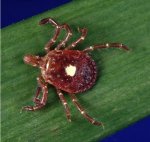Ecoclimber
Senior Member
- Messages
- 1,011
Man's Ravaging Lyme Disease Eludes Doctors for a Year
Jul 8, 2014, 5:18 AM ET
By SUSAN DONALDSON JAMES
Susan Donaldson James More from Susan »

Digital Reporter
via Good Morning America

Allen Bargfrede, seen with a deer tick, got Lyme disease in Spain, but couldn't get a definitive diagnosis when he returned to the United States.
Allen Bargfrede said he was jumping into the shower when he spotted a tiny tick on his ankle that would change his life.
“I washed it off and didn’t think about it anymore,” said the 39-year-old associate professor of music business at Berklee College of Music in Boston, who was in Spain at the time for a conference. “I remember thinking to myself, ‘I hope I don’t get sick from that.’”
Two days later, Bargfrede said he developed the classic bull’s eye rash of Lyme disease, a bacterial infection transmitted through tick bites. The rash eventually gave way to a fever, cough and “strange headaches,” he said.
“I had severe anxiety,” said Bargfrede, who was getting ready to head home to the U.S. when the symptoms began to worsen. “I was crazy scared to get on an airplane.”
Bargfrede said it took nearly a year to confirm that he had Lyme disease after a string of “negative” tests, dangerous treatments and disbelief from most of his American doctors. ...
....According to the CDC, the cause of Lyme disease is the bacterium Borrelia burgdorferi, and the agency’s recommended test only detects that particular species. But Bargfrede’s illness was caused by Borrelia garinii, a species that’s prevalent in Europe but not in the United States.
Bargfrede had a C6-based ELISA test, which is widely used in Europe and can detect as many as 18 species of the Borrelia bacterium. But the test is not used in the U.S., according to the CDC....
...An exemption in federal regulations allows many labs to offer Lyme tests without proof that they accurately identify the disease.....a cottage industry of more than 70 alternative tests has cropped up in labs around the country, some reputable and some not....
...Blood tests are not helpful in Lyme disease, according to Mead, because the Borrelia bacterium is a spirochete that quickly leaves the bloodstream and “burrows” into other parts of the body.....
For the remaining article click on link here or above
Also:
---------------------------------------------------------------------------------------------------------------------
Additional cases of Lyme disease have been found in patients from several states in the southeastern U.S. by Professor Kerry Clark, associate professor of public health at the University of North Florida in Jacksonville, FL and his colleagues.
These cases include two additional Lyme disease Borrelia species recently identified in patients in Florida and Georgia. Overall, 42 percent of 215 patients from southern states tested positive for some Lyme Borrelia species. More than 90 cases of Lyme infection were confirmed among patients from Florida, Georgia, North Carolina, Texas and Virginia.
Also in Southern States two additional Lyme disease Borrelia species which have been discovered that produce Lyme disease: B. americana and B. andersonii. They provide additional evidence that multiple Lyme Borrelia species are associated with human disease in the U.S.including ,B. bissettii and Borrelia burgdorferi similar to the situation in Europe.
Current testing methods and interpretation criteria, designed to detect just one species (B. burgdorferi), may explain many of the complaints involving the unreliability of Lyme disease tests in the U.S.
Most of the patients included in Clark's study were suffering from a variety of chronic health problems, such as fatigue, headaches, muscle and joint pain and cognitive dysfunction. As a result, Clark's research may help millions of chronically ill people living in areas where Lyme disease wasn't previously recognized. Called "The New Great Imitator," Lyme disease is often mistaken for illnesses such as fibromyalgia, chronic fatigue syndrome, lupus, multiple sclerosis, rheumatoid arthritis, Lou Gehrig's disease (ALS), Parkinson's, ADHD and even Alzheimer's.
University of North Florida. "Lyme disease confirmed in humans from southern states." ScienceDaily. ScienceDaily, 13 May 2014. www.sciencedaily.com/releases/2014/05/140513091115.htm>.
---------------------------------------------------------------------------------------------------------------------------
Might as well get them all out there:
Hartland Virus
Rocky Mountain Spotted Fever
A New Tick-Borne Parasite That Invades Red Blood Cells: Beware Babesiosis
According to Columbia University’s comprehensive report, Babesiosis can be fatal in up to 20 percent of people with such immune-compromising problems.
There is another thread on this subject that you may find interesting
Lyme Disease: Discovery of other Reservoirs for ticks
Jul 8, 2014, 5:18 AM ET
By SUSAN DONALDSON JAMES
Susan Donaldson James More from Susan »

Digital Reporter
via Good Morning America

Allen Bargfrede, seen with a deer tick, got Lyme disease in Spain, but couldn't get a definitive diagnosis when he returned to the United States.
Allen Bargfrede said he was jumping into the shower when he spotted a tiny tick on his ankle that would change his life.
“I washed it off and didn’t think about it anymore,” said the 39-year-old associate professor of music business at Berklee College of Music in Boston, who was in Spain at the time for a conference. “I remember thinking to myself, ‘I hope I don’t get sick from that.’”
Two days later, Bargfrede said he developed the classic bull’s eye rash of Lyme disease, a bacterial infection transmitted through tick bites. The rash eventually gave way to a fever, cough and “strange headaches,” he said.
“I had severe anxiety,” said Bargfrede, who was getting ready to head home to the U.S. when the symptoms began to worsen. “I was crazy scared to get on an airplane.”
Bargfrede said it took nearly a year to confirm that he had Lyme disease after a string of “negative” tests, dangerous treatments and disbelief from most of his American doctors. ...
....According to the CDC, the cause of Lyme disease is the bacterium Borrelia burgdorferi, and the agency’s recommended test only detects that particular species. But Bargfrede’s illness was caused by Borrelia garinii, a species that’s prevalent in Europe but not in the United States.
Bargfrede had a C6-based ELISA test, which is widely used in Europe and can detect as many as 18 species of the Borrelia bacterium. But the test is not used in the U.S., according to the CDC....
...An exemption in federal regulations allows many labs to offer Lyme tests without proof that they accurately identify the disease.....a cottage industry of more than 70 alternative tests has cropped up in labs around the country, some reputable and some not....
...Blood tests are not helpful in Lyme disease, according to Mead, because the Borrelia bacterium is a spirochete that quickly leaves the bloodstream and “burrows” into other parts of the body.....
For the remaining article click on link here or above
Also:
---------------------------------------------------------------------------------------------------------------------
Additional cases of Lyme disease have been found in patients from several states in the southeastern U.S. by Professor Kerry Clark, associate professor of public health at the University of North Florida in Jacksonville, FL and his colleagues.
These cases include two additional Lyme disease Borrelia species recently identified in patients in Florida and Georgia. Overall, 42 percent of 215 patients from southern states tested positive for some Lyme Borrelia species. More than 90 cases of Lyme infection were confirmed among patients from Florida, Georgia, North Carolina, Texas and Virginia.
Also in Southern States two additional Lyme disease Borrelia species which have been discovered that produce Lyme disease: B. americana and B. andersonii. They provide additional evidence that multiple Lyme Borrelia species are associated with human disease in the U.S.including ,B. bissettii and Borrelia burgdorferi similar to the situation in Europe.
Current testing methods and interpretation criteria, designed to detect just one species (B. burgdorferi), may explain many of the complaints involving the unreliability of Lyme disease tests in the U.S.
Most of the patients included in Clark's study were suffering from a variety of chronic health problems, such as fatigue, headaches, muscle and joint pain and cognitive dysfunction. As a result, Clark's research may help millions of chronically ill people living in areas where Lyme disease wasn't previously recognized. Called "The New Great Imitator," Lyme disease is often mistaken for illnesses such as fibromyalgia, chronic fatigue syndrome, lupus, multiple sclerosis, rheumatoid arthritis, Lou Gehrig's disease (ALS), Parkinson's, ADHD and even Alzheimer's.
University of North Florida. "Lyme disease confirmed in humans from southern states." ScienceDaily. ScienceDaily, 13 May 2014. www.sciencedaily.com/releases/2014/05/140513091115.htm>.
---------------------------------------------------------------------------------------------------------------------------
Might as well get them all out there:
Hartland Virus
Rocky Mountain Spotted Fever
A New Tick-Borne Parasite That Invades Red Blood Cells: Beware Babesiosis
According to Columbia University’s comprehensive report, Babesiosis can be fatal in up to 20 percent of people with such immune-compromising problems.
There is another thread on this subject that you may find interesting
Lyme Disease: Discovery of other Reservoirs for ticks
Last edited:





